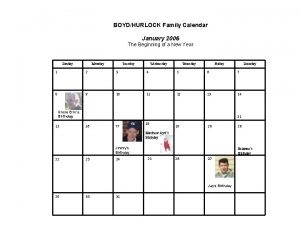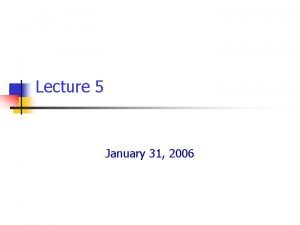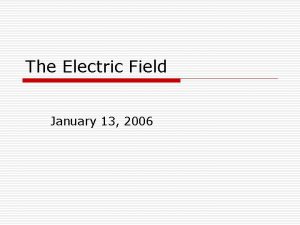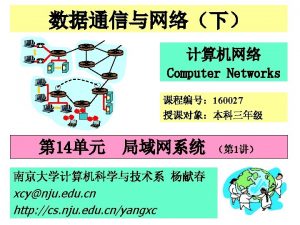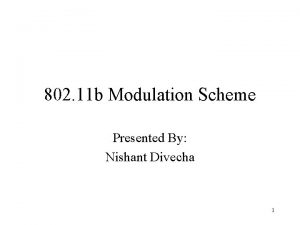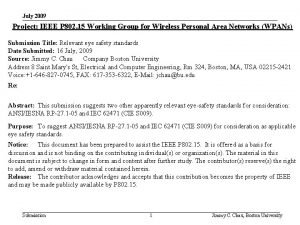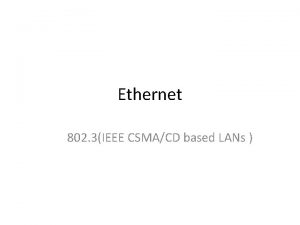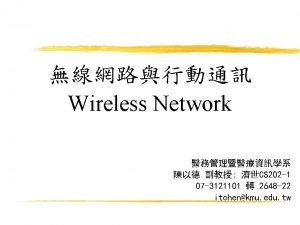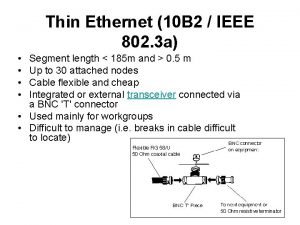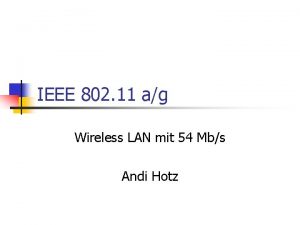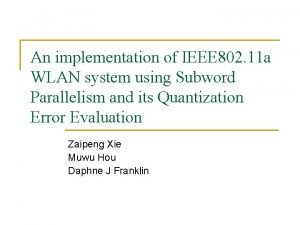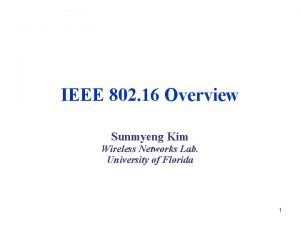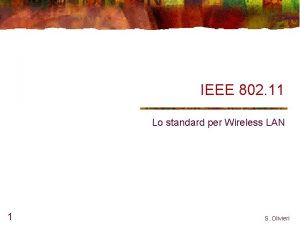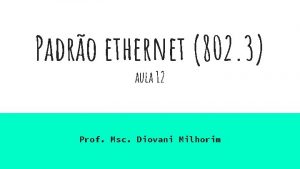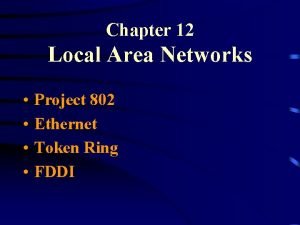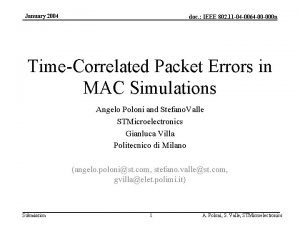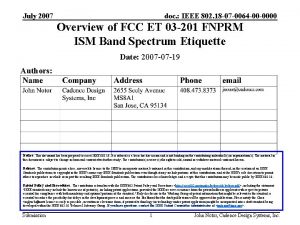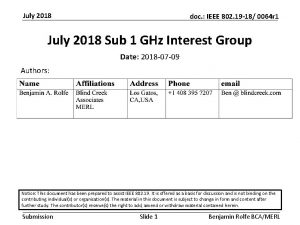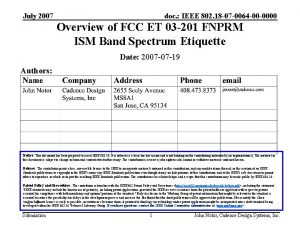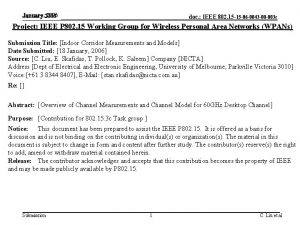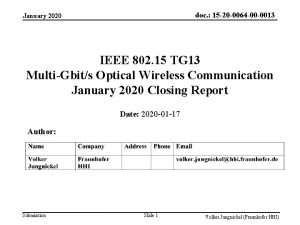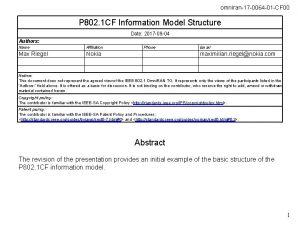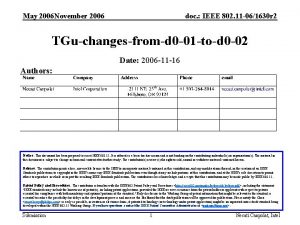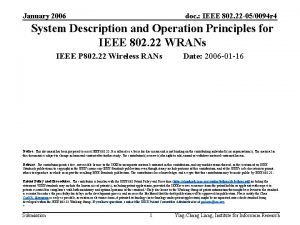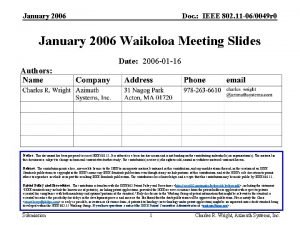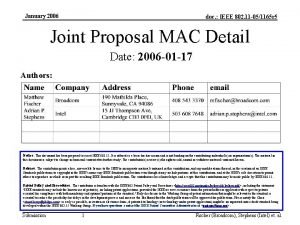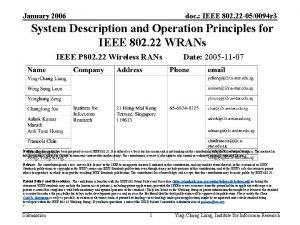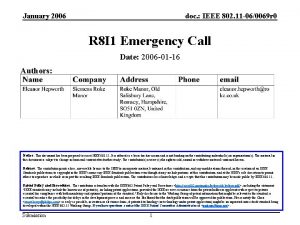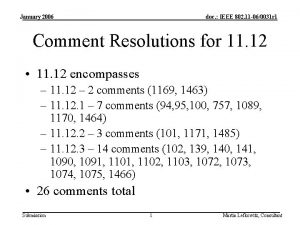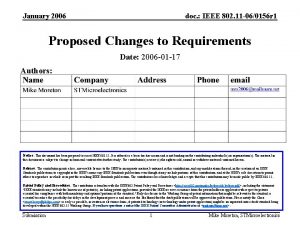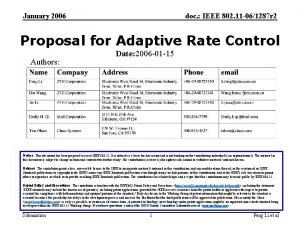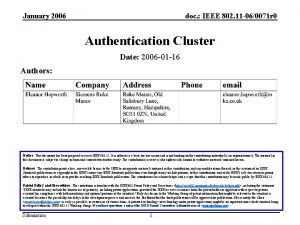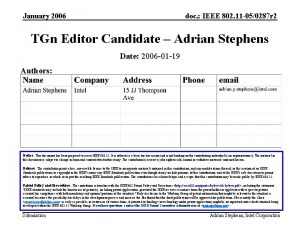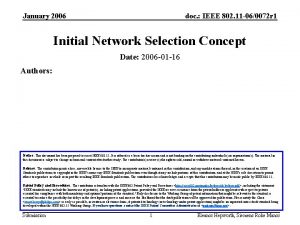January 2006 doc IEEE 802 15 06 0064






























- Slides: 30

January 2006 doc. : IEEE 802. 15 -06 -0064 -00 -0005 Project: IEEE P 802. 15 Working Group for Wireless Personal Area Networks (WPANs) Submission Title: [Mobility Issues and Their Solutions for Mesh Networks] Date Submitted: [19 January, 2006] Source: [Ho-In Jeon (1), Yong-Bae Kim (2), Bum-Joo Kim (2), Yongsik Shin (3)] Company: [Dept. EE, Kyung-Won University (KWU) (1), Leii. Tech Inc. (2), SKTelecom (3)] Address: [San 65, Bok-Jung-Dong, Sung-Nam-Shi, Kyung-Gi-Do, Republic of Korea] Voice 1: [ +82 -31 -753 -2533], Voice 2: [ +82 -19 -9101 -1394] FAX: [+82 -31 -753 -2532], E-Mail: [jeon 1394@kornet. net] Re: [This work has been supported partly by ITRC. ] Abstract: [This document addresses Mobility Issues and Their Solutions for Mesh Networks. ] Purpose: [Final Proposal for the IEEE 802. 15. 5 Standard] Notice: This document has been prepared to assist the IEEE P 802. 15. It is offered as a basis for discussion and is not binding on the contributing individual(s) or organization(s). The material in this document is subject to change in form and content after further study. The contributor(s) reserve(s) the right to add, amend or withdraw material contained herein. Release: The contributor acknowledges and accepts that this contribution becomes the property of IEEE and may be made publicly available by P 802. 15. Submission 1 Ho-In Jeon, (Kyung-Won University), Yongsik Shin (SKTelecom)

January 2006 doc. : IEEE 802. 15 -06 -0064 -00 -0005 Mobility Issues and Their Solutions for Mesh Networks Ho-In Jeon, Yong-Bae Kim, and Bum-Joo Kim Kyung-Won University, HNRC of IITA, Republic of Korea Yongsik Shin SKTelecom, Republic of Korea Submission 2 Ho-In Jeon, (Kyung-Won University), Yongsik Shin (SKTelecom)

January 2006 doc. : IEEE 802. 15 -06 -0064 -00 -0005 Contents • Introduction • Issues of Mesh Networks • A Scenario for the operation of Mesh Network • Mobility Support of Mesh Networks – Node Mobility – Whole PAN Mobility • Solutions for the Mobility Issues • Features of the proposed Scheme • Conclusion Submission 3 Ho-In Jeon, (Kyung-Won University), Yongsik Shin (SKTelecom)

January 2006 doc. : IEEE 802. 15 -06 -0064 -00 -0005 Issues of Mesh Networks • Beacon Scheduling for Collision Avoidance • Short Address Allocation Algorithms • Routing Algorithm: Proactive or Reactive • Power-Efficient Operational Mode • Qo. S Support • Adoption of RTS/CTS for Data Transmission • Mobility Support for Mesh Devices and Mesh PANs Submission 4 Ho-In Jeon, (Kyung-Won University), Yongsik Shin (SKTelecom)

January 2006 doc. : IEEE 802. 15 -06 -0064 -00 -0005 U-Home with Mesh Network Washer Utility Mesh Room DTV Room #2 PC DCam. Gas Mesh Meter Gas Oven Microwave Oven Room #3 PC VPhone Refrig. Kitchen Oven : IEEE 1394 or UWB Connectivity : IEEE 802. 11 x, 15. 3, Zig. Bee/15. 4, 15. 5 Mesh VPhone DTV Room #1 DTV PVR PDA Phone Jack PVR DCam. DAM HS/ AP or MMRG PNC Cable, Satellite, Terrestrial Submission Living Room Zig. Bee/15. 4 802. 11 a/g/n/e, IEEE 802. 15. 3 FTTH 5 PDA Bathroom DTV STB Mesh PNC VDSL MODEM Room #4 PC PDA Printer Phone Jack Door Phone Meter Reader Power Meter Water Meter DCam. DSLAM ONU Internet Ho-In Jeon, (Kyung-Won University), Yongsik Shin (SKTelecom)

January 2006 doc. : IEEE 802. 15 -06 -0064 -00 -0005 Why Mobility Issues for Mesh Networks • Users carry mesh nodes that are capable of being PNC. – PNC as well as mesh nodes transmits beacons – The PNC can have more than one mesh device that have been associated with it, forming a mesh PAN • When he returns back to his house, the U-terminal is assumed to behave like a universal remote controller. – The whole PAN is moving causing some problems. – Here are some scenarios for the mobility support • Most important services for the U-Home services. Submission 6 Ho-In Jeon, (Kyung-Won University), Yongsik Shin (SKTelecom)

January 2006 doc. : IEEE 802. 15 -06 -0064 -00 -0005 A Scenario for Mesh Network Operations 1 4 2 PNC 6 2 1 9 5 9 6 3 4 7 8 • Issues to be resolved – – Association and Reassociation Procedure Beacon Scheduling Short Address Allocations Creation and Update of Neighborhood Table Submission 7 Ho-In Jeon, (Kyung-Won University), Yongsik Shin (SKTelecom)

January 2006 doc. : IEEE 802. 15 -06 -0064 -00 -0005 PNC Formation of the Mesh 1 1 PNC • Device 1 first scans passively first and actively next. • When it finds that there is no device that he can associate with, it becomes the PNC. • Once a device becomes a PNC, it starts to transmit its beacon at the beginning of the superframe. Submission 8 Ho-In Jeon, (Kyung-Won University), Yongsik Shin (SKTelecom)

January 2006 1 doc. : IEEE 802. 15 -06 -0064 -00 -0005 Joining of Device 2 to the Mesh 2 1 2 PNC • Dev. 2 hears the beacon form PNC and gets associated with it. • When associated, it gets PANID, Short Address, and other sets of information from PNC and determines when to send its beacon. • Dev. 1 and 2 listen to beacons of each other and store information about their neighbor in the Neighborhood Table. Submission 9 Ho-In Jeon, (Kyung-Won University), Yongsik Shin (SKTelecom)

January 2006 doc. : IEEE 802. 15 -06 -0064 -00 -0005 Association Relations and Beacon Tx • Solid blue line represents the Parent-Child relations based on associations. • Red line represents directly reachable. • Every mesh device except leaf nodes transmits beacon during the BOP (Beacon. Only Period) to save BOP usage. • Beacon scheduling has been applied. 2 1 PNC 3 Superframe Active Period Inactive Period CAP BOP 1 2 3 Submission 10 Ho-In Jeon, (Kyung-Won University), Yongsik Shin (SKTelecom)

January 2006 doc. : IEEE 802. 15 -06 -0064 -00 -0005 Association and Direct Links Relations 1 4 2 PNC 6 2 1 9 5 9 6 3 4 7 1 2 3 4 5 6 8 8 CAP BOP 7 9 Submission 11 Ho-In Jeon, (Kyung-Won University), Yongsik Shin (SKTelecom)

January 2006 doc. : IEEE 802. 15 -06 -0064 -00 -0005 Association and Direct Links Relations 2 5 9 1 PNC 6 4 3 8 7 • Blue Line: Association Relations • Red Line: Direct Communication Capable • Association Policy – New nodes are associated with the nodes which are as close to the PNC and possible – If RSSI is not high enough for reliable communications, then it can choose other node as its parent. Submission 12 Ho-In Jeon, (Kyung-Won University), Yongsik Shin (SKTelecom)

January 2006 doc. : IEEE 802. 15 -06 -0064 -00 -0005 Differences from Current Baseline • The Baseline Document for HR mesh does not perform association process, and thus no PNC concept. – A new device does not know when the superframe has started. – There is no information whether a new device may send his beacon prior to the first beacon transmission time. – No common PAN_ID guaranteed. • The proposed mesh network starts from PNC having parent-child relations and direct communication links. – The superframe structure is determined by the PNC. – Every node knows exactly when the superframe started. – Consistent PAN-ID Submission 13 Ho-In Jeon, (Kyung-Won University), Yongsik Shin (SKTelecom)

January 2006 doc. : IEEE 802. 15 -06 -0064 -00 -0005 The Mobility Scenarios • Only one non-PNC device is moving • A Coordinator having its children is moving • The whole PAN is moving and joining the other WPAN – PNC to PNC Connection – PNC to Coordinator Connection – Coordinator to End Device Connection – End Device to End Device Connection Submission 14 Ho-In Jeon, (Kyung-Won University), Yongsik Shin (SKTelecom)

January 2006 doc. : IEEE 802. 15 -06 -0064 -00 -0005 One non-PNC Device is Moving • Issues – Fast Reassociation needed – Short address assigned can be retained PNC Submission device coordinator 15 Ho-In Jeon, (Kyung-Won University), Yongsik Shin (SKTelecom)

January 2006 doc. : IEEE 802. 15 -06 -0064 -00 -0005 The Coordinator is Moving • Issues – Beacon Conflicts – Beacon rescheduling – Orphan node treatment PNC Submission device coordinator 16 Ho-In Jeon, (Kyung-Won University), Yongsik Shin (SKTelecom)

January 2006 doc. : IEEE 802. 15 -06 -0064 -00 -0005 The problem when the Coordinator is moving Node 7 Node 2 Node 1 Orphan : Beacon : CAP PNC Node 1 Node 7 Node 2 Beacon Conflict due to the movement of the Coordinator Submission 17 Ho-In Jeon, (Kyung-Won University), Yongsik Shin (SKTelecom)

January 2006 doc. : IEEE 802. 15 -06 -0064 -00 -0005 PNC to PNC Connection I 2 E 1 End Device B 1 D 2 Coordinator H 2 F 1 PNC J 1 G 1 C 2 A 1 PNC 2 Coordinator End Device G 2 F 2 J 2 End Device H 1 B 2 D 1 E 2 I 1 Submission PAN_1 End Device PAN_2 18 Ho-In Jeon, (Kyung-Won University), Yongsik Shin (SKTelecom)

January 2006 doc. : IEEE 802. 15 -06 -0064 -00 -0005 PNC to Coordinator Connection E 1 End Device B 1 Coordinator A 2 PNC 2 F 1 PNC J 1 G 1 C 1 A 1 B 2 Coordinator D 2 C 2 End Device H 1 E 2 D 1 F 2 K 2 H 2 I 2 Coordinator End Device I 1 Submission PAN_1 PAN_2 19 J 2 End Device Ho-In Jeon, (Kyung-Won University), Yongsik Shin (SKTelecom)

January 2006 doc. : IEEE 802. 15 -06 -0064 -00 -0005 Coordinator to Coordinator Connection A 1 PNC POS A 2 PNC Coordinator C 1 B 1 End Device F 1 K 1 Coordinator D 1 Coordinator H 1 End Device E 2 F 2 D 2 C 2 K 2 H 2 I 2 End Device J 1 J 2 PAN_1 Submission B 2 PAN_2 20 Ho-In Jeon, (Kyung-Won University), Yongsik Shin (SKTelecom)

January 2006 doc. : IEEE 802. 15 -06 -0064 -00 -0005 Coordinator to Device Connection A 2 POS A 1 PNC Coordinator B 2 D 2 Coordinator D 1 C 1 B 1 E 2 F 2 K 2 End Device Coordinator E 1 End Device F 1 Coordinator PAN_1 Submission K 1 H 1 End Device J 1 21 H 2 I 2 End Device J 2 PAN_2 Ho-In Jeon, (Kyung-Won University), Yongsik Shin (SKTelecom)

January 2006 doc. : IEEE 802. 15 -06 -0064 -00 -0005 Device to Device Connection A 1 A 2 Coordinator F 1 K 1 End Device Coordinator I 1 H 1 POS D 2 K 2 H 2 End Device J 2 PAN_1 Submission F 2 End Device Coordinator End Device J 1 E 2 PNC C 2 B 2 D 1 C 1 B 1 E 1 PNC 22 Ho-In Jeon, (Kyung-Won University), Yongsik Shin (SKTelecom) I 2

January 2006 doc. : IEEE 802. 15 -06 -0064 -00 -0005 Mobility Issues Revisited Mobile_PAN Moving Fixed_PAN PNC device • Assumptions of Mobile_PAN : Every device that belongs to Mobile PAN moves together in the most practical case Submission 23 PNC Coordinator Device Ho-In Jeon, (Kyung-Won University), Yongsik Shin (SKTelecom)

January 2006 doc. : IEEE 802. 15 -06 -0064 -00 -0005 Cases for Device Mobility • When the two PANs are using same channel – – Mobile PAN and Fiexed PAN causes beacon conflict Data conflict due to the beacon conflict The Beacon Rescheduling is needed. The two PANs naturally merge. • When the two PANs are using different channels – They behave like the other WPAN does not even exist. – Some scanning mechanism is needed for the combination of the two WPANs Submission 24 Ho-In Jeon, (Kyung-Won University), Yongsik Shin (SKTelecom)

January 2006 doc. : IEEE 802. 15 -06 -0064 -00 -0005 Different Channel Cases • Estimated time required to merge two PANs that are using two different channels – There are 16 Channels for 2. 4 GHz band – Scan-Duration for 1 channel = a. Base. Superframe. Duration x (2 n+1) ; n = 0~14 – min. Scan. Duration = 960 x 2 = 1920 [Symbols] = 30. 72 [msec] – max. Scan. Duration = 960 x (214+1) = 15729600 [Symbols] = 2, 516. 73 [sec] – It takes 11 hours maximum for scanning 16 channels Submission 25 Ho-In Jeon, (Kyung-Won University), Yongsik Shin (SKTelecom)

January 2006 doc. : IEEE 802. 15 -06 -0064 -00 -0005 New Search Command for Solutions Command Frame Identifier Command Name 0 x 01 Association request 0 x 02 Association response 0 x 03 Disassociation notification 0 x 04 Data request 0 x 05 PAN ID conflict notification 0 x 06 Orphan notification 0 x 07 Beacon request 0 x 08 Coordinator realignment 0 x 09 GTS request 0 x 0 a Search. New. Pan request 0 x 0 b Search. New. Pan response 0 x 0 c-oxff Reserved Submission 26 Name Scan. Type Description 0 x 00 = energy detection scan 0 x 01 = active scan 0 x 02 = passive scan 0 x 03 = orphan scan 0 x 04 = search other PAN Ho-In Jeon, (Kyung-Won University), Yongsik Shin (SKTelecom)

January 2006 doc. : IEEE 802. 15 -06 -0064 -00 -0005 Timing Charts for Searching PAN Mobile PAN Higher Layer Mobile PAN MAC Fixed PAN MAC MLME-SCAN. request Search. New. PAN command Acknowledgement Scan Duration MLME-BEACONNOTIFY. indication Search. New. PAN response Acknowledgement MLME-SCAN. confirm Submission 27 Ho-In Jeon, (Kyung-Won University), Yongsik Shin (SKTelecom)

January 2006 doc. : IEEE 802. 15 -06 -0064 -00 -0005 Solutions by Using Beacon Payload Name Type Value Search_superframe boolean True or False Search. Pan. Duration integer 0 x 0 e New. Pan. Exist boolean True or False New. Pan. Channel bitmap 32 bit New. Pan. Id integer 0 xffff Submission 28 Ho-In Jeon, (Kyung-Won University), Yongsik Shin (SKTelecom)

January 2006 doc. : IEEE 802. 15 -06 -0064 -00 -0005 Conclusions • The PNC formation follows the way similar to IEEE 802. 15. 4 • Most applications require mobility of mesh nodes. • Beacon scheduling is assumed to be done. • Mobility causes some problems. • Some scenarios have been identified, and some solutions are presented using new Search Command. • More efforts will be made and presented in the near future. Submission 29 Ho-In Jeon, (Kyung-Won University), Yongsik Shin (SKTelecom)

January 2006 doc. : IEEE 802. 15 -06 -0064 -00 -0005 Acknowledgment • This work has been supported partly by HNRC of IITA. Submission 30 Ho-In Jeon, (Kyung-Won University), Yongsik Shin (SKTelecom)
 Bridges from 802.x to 802.y
Bridges from 802.x to 802.y Bridges from 802.x to 802.y
Bridges from 802.x to 802.y January 2006 calendar
January 2006 calendar January 31 2006
January 31 2006 January 13 2006 calendar
January 13 2006 calendar January 2017 chemistry regents answers
January 2017 chemistry regents answers Ieee 802
Ieee 802 Arquitetura ieee 802
Arquitetura ieee 802 Estandares 802
Estandares 802 Ieee 802 standard
Ieee 802 standard 802 15
802 15 802 ieee
802 ieee Ieee 802
Ieee 802 Ieee 802 family
Ieee 802 family Ieee 802 3 compliance
Ieee 802 3 compliance 802 protocols
802 protocols 802 11
802 11 Sybex ccna
Sybex ccna 09 802 0561
09 802 0561 Ethernet 802
Ethernet 802 802 family
802 family 802-3-ethernet
802-3-ethernet Lan 701
Lan 701 Wireless lan 802
Wireless lan 802 Wlan 802
Wlan 802 Modulation coding scheme
Modulation coding scheme 802/11
802/11 Ssin-802
Ssin-802 802 3
802 3 Project 802
Project 802 Mac address
Mac address


